#zadar region
Explore tagged Tumblr posts
Text
🌍 Wettervergleich: Insel Rab vs. Nord- & Mittelhessen 🌤️
Ein spannender Blick auf das Wetter – perfekt für alle, die wissen möchten, wie es woanders aussieht! 👇
📍 Insel Rab, Kvarner Bucht, Primorje, Kroatien
🌡️ 10 °C | 🌊 Wassertemperatur: 12 °C
💨 Starker Bora-Wind (65-110 km/h)
🌫️ Luftfeuchtigkeit: 60-70 % | 📉 Luftdruck: 1016 hPa
⚠️ Wetterwarnung: Vorsicht vor heftigen Böen!
📍 Seeweiher Mengerskirchen, Mittelhessen
🌡️ 1-2 °C | 💨 Ruhiger Wind (5-10 km/h)
🌫️ Luftfeuchtigkeit: 80 % | 📉 Luftdruck: 1021 hPa
☀️ Nebel am Morgen, später aufklarend. Ab morgen: frostig & sonnig!
📍 Homberg (Efze), Nordhessen
🌡️ 0-3 °C | 💨 Ruhiger Wind (5-10 km/h)
🌫️ Luftfeuchtigkeit: 82 % | 📉 Luftdruck: 1020 hPa
☀️ Morgens Nebel, später Sonne – ideales Wetter für Outdoor-Aktivitäten!
📍 Wettesingen (Breuna), (Nordhessen)
🌡️ 0-2 °C | 💨 Ruhiger Wind (5-10 km/h)
🌫️ Luftfeuchtigkeit: 85 % | 📉 Luftdruck: 1022 hPa
☀️ Nebel am Morgen, später Mix aus Wolken & Sonne.
✨ Fazit:
Die Insel Rab lockt mit mildem Wetter, aber aktuell mit heftigen Bora-Winden. 🌬️ In Hessen ist es kühler und ruhig – perfekt für Spaziergänge in Wäldern und am See. ❄️
🌟 Kroatien oder Deutschland? Oder wo zieht es euch hin? 🤔
Kleine Info:
Die Kvarner Bucht gehört nicht zu Dalmatien, sondern zum kroatischen Küstenland (Primorje). Dalmatien beginnt südlich der Kvarner Bucht (ab Zadar). Inseln wie Rab, Krk und Lošinj sind Teil dieser einzigartigen Region zwischen Istrien und Dalmatien.
💡 Ich selbst träume davon, trotz #mecfs wieder salzige milde Luft an der Küste zu genießen – sei es zur Algenblüte auf Rab im Frühling, Touristen noch spärlich im April/Mai, oder im milden trockenen September.
Ansonsten zu trockenen, warmen Zeiten gern wieder Richtung Greetsiel, Norddeich, Neuharlingersiel, Husum, Insel Langeoog oder Spiekeroog, Borkum, oder auch Richtung Varel an die Nordsee oder doch die schöne, mildere Ostsee mit Pelzerhaken und Retin, vielleicht mal Wismar, Boltenhagen oder Usedom oder gar Insel Fehmarn oder die Ostsee Inseln Dänemarks?! 🌊
#Wettervergleich #InselRab #nordsee #ostsee #Nordhessen #Mittelhessen #Kroatien #KvarnerBucht #Primorje #mecfs #cwg64d #oculiauris #mecfsnordhessen
6 notes
·
View notes
Text
A long time ago I translated some article snippets on UFO sightings in Yugoslavia. Nothing substantial but the presence of the phenomenon is interesting.
About a month later, at the end of January 1968, the same media again broadcast events from Rijeka. This time, Ante Glavina, an official in the administration of the Municipal Assembly, came forward claiming that he saw an unknown object. "I was on the terrace of the building with my wife and suddenly noticed a bright moon-shaped object at an indefinite height, but much larger. An unknown body spun in a spiral and thus moved northeast across the Sušak hospital building," Glavina told Vjesnik. It is especially interesting to mention Vjesnik's almost incidental comment from the same article: "We received similar information from some other citizens." Even more interesting is the writing of Vjesnik from the autumn of 1971, when they got access to an authentic conversation between the Regional Aircraft Control Center of Zagreb Airport and JAT's Convair 440 on the flight between Pula and Zagreb. At that time, sightings of an unknown body over Kvarner were frequent, and after a "military person" from Pula reported seeing a rhomboid body somewhere above Lošinj, the flight control contacted the plane to ask if they saw anything in the sky. Flight Control: What is the visibility in your field of vision? Plane: Very good. Control: If you can, take a look there somewhere towards the coast between Zadar and Rijeka, again some flying objects in course 160 have been spotted. Plane: Thank you. Visibility is great, but we don't see anything yet, if we see it, we'll let you know.
Control: Be kind, look at Rijeka as well. Flight control from Rijeka reported two flying light objects on course 140 from Rijeka. Plane: We saw it in Pula, it's the bodies that the press writes about, luminous objects at a height of four to five kilometers, as we have seen before over Nis, Subotica, Kikinda. Control: Can you describe to us what these bodies look like?
19 notes
·
View notes
Text
Zadar, Croatia
Visitors may enjoy an exquisite blend of historic and contemporary charm in Zadar, a coastal city in Croatia. The Old Town in Zadar is unquestionably a must-see location. Some of the city's most recognisable landmarks, such as the Roman Forum, the Church of Saint Donatus, and the Cathedral of Saint Anastasia, are located in this region.
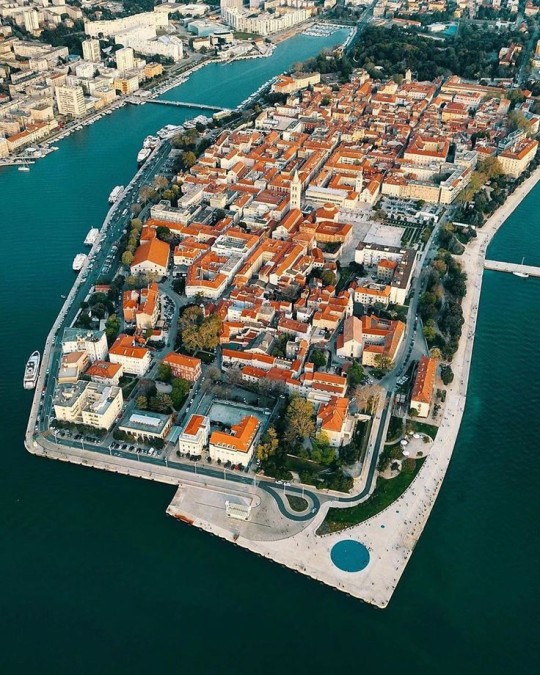
8 notes
·
View notes
Text
Explore Croatia: Investment Opportunities Leading to EU Residency
Discover Croatia: Europe’s Hidden Gem for Citizenship and Investment Opportunities
Tucked along the sparkling coastline of the Adriatic Sea, Croatia is more than just a traveler's paradise—it's fast becoming one of the most attractive destinations for individuals seeking a high-quality lifestyle, financial opportunities, and a gateway to the European Union through citizenship and residency by investment.
From its medieval cities and pristine beaches to its booming real estate sector and investor-friendly policies, Croatia stands tall as a powerful contender in the global investment migration landscape. In this article, we’ll explore the full picture—why Croatia, what makes it appealing for investors and expats, and how acquiring residency or citizenship through investment could be a life-changing opportunity.
1. A Glimpse Into Croatia: The Land of a Thousand Islands
Croatia, located in Southeast Europe, is bordered by Slovenia, Hungary, Serbia, Bosnia & Herzegovina, and Montenegro. The country boasts over 1,200 islands, a rich cultural heritage, and UNESCO-protected landmarks. Its capital city, Zagreb, serves as a business and political hub, while coastal cities like Split, Dubrovnik, and Zadar draw millions of tourists each year.
What sets Croatia apart is its blend of modern lifestyle and old-world charm. Walking through its cities feels like stepping into history, with Roman ruins, Venetian palaces, and Gothic cathedrals dotting the landscape. At the same time, Croatia is firmly part of the modern European framework—it joined the European Union in 2013, the Schengen Area in 2023, and adopted the Euro in 2023, making travel and business within Europe easier than ever.
2. Why Croatia is a Smart Choice for Investors
While many countries in Europe are saturated and expensive, Croatia offers a perfect balance of affordability, safety, and opportunity. Here’s why investors are increasingly turning their attention to Croatia:
a) Booming Real Estate Market
Croatia’s property market has seen a steady rise in value, especially along the coast. The demand for holiday homes, rental properties, and commercial real estate is increasing, particularly in tourist hotspots. Investors can expect strong ROI, especially through vacation rentals during the summer season.
b) Strategic Location
Croatia serves as a gateway between Central and Southeast Europe. Its central location makes it ideal for international business and trade, with well-developed infrastructure, ports, and highways.
c) EU and Schengen Membership
As an EU member, Croatia offers access to the world’s largest single market. Residency or citizenship in Croatia grants visa-free or visa-on-arrival access to over 170 countries, including full freedom to live, work, and travel within the EU.
d) Political and Economic Stability
Croatia is one of the more stable countries in the Balkan region, with low crime rates and a strong legal system. The government actively encourages foreign direct investment (FDI), especially in sectors like tourism, energy, real estate, and agriculture.
3. Lifestyle in Croatia: A European Dream Come True
It’s not just about the economy—Croatia offers a lifestyle that’s hard to beat. Whether you’re seeking a peaceful coastal retirement or an active, nature-filled family life, Croatia has it all.
a) Mediterranean Climate
Croatia enjoys over 2,600 hours of sunshine a year, particularly along the coast. The mild winters and warm summers make it an attractive destination year-round.
b) Affordable Living
Compared to Western Europe, Croatia offers a high standard of living at a lower cost. Expenses like healthcare, transportation, dining, and housing are significantly more affordable than in countries like Germany, France, or Italy.
c) Excellent Healthcare and Education
Croatia has a universal healthcare system, which is well-regarded and accessible. Additionally, education is free and compulsory until the age of 15, with several international schools catering to expat families.
d) Vibrant Expat Community
With growing numbers of digital nomads, retirees, and entrepreneurs choosing Croatia, expat communities are thriving. English is widely spoken, especially among the younger population and in urban areas.
4. Citizenship and Residency Through Investment: Your Path to Croatia
Now that you understand the advantages of living and investing in Croatia, let’s talk about how you can legally establish your residency or citizenship through investment.
a) Residency by Investment
Foreign nationals can obtain temporary residency in Croatia through various means, including:
Starting a company in Croatia (a d.o.o. or LLC)
Investing in real estate
Opening a branch of a foreign company
Self-employment or entrepreneurship
A common route is to establish a business in Croatia and employ yourself as a managing director. You must prove economic activity, such as paying taxes, employing local staff, or maintaining a minimum capital investment. After 5 years of continuous temporary residency (and fulfilling integration requirements), you can apply for permanent residency.
b) Citizenship by Naturalization
To qualify for Croatian citizenship, you usually need to:
Reside in Croatia for at least 8 years with permanent residency
Demonstrate language proficiency
Show cultural integration
However, under certain circumstances, the process can be expedited:
Ethnic Croats and descendants have a simplified path
Marrying a Croatian citizen
Significant contribution to the Republic of Croatia, such as economic investment, can also speed up the process
5. The Business Advantage: What You Can Invest In
Croatia’s investment potential is huge and diversified. Depending on your goals, here are some sectors you can explore:
a) Tourism & Hospitality
The tourism sector accounts for nearly 20% of Croatia’s GDP. Investing in boutique hotels, rental villas, eco-resorts, or tourism-related services can be highly profitable.
b) Real Estate Development
There’s strong demand for new housing, especially in growing urban centers and coastal towns. Projects like apartment complexes, retirement homes, and vacation properties are in demand.
c) Agriculture and Organic Farming
Croatia has fertile land and growing global demand for organic and local produce. Investments in olive oil production, vineyards, lavender farms, or sustainable agriculture can offer long-term returns.
d) Renewable Energy
Croatia is committed to transitioning to green energy. Solar, wind, and hydroelectric projects have significant backing from the EU, making this a promising area for forward-thinking investors.
6. Living the Croatian Life: A Realistic View for Expats
Moving to a new country comes with challenges—but in Croatia, the benefits outweigh the obstacles. Here’s what to expect:
a) Bureaucracy
Croatia is still developing its digital services, so paperwork and in-person appointments can be slow. Having local support or a consultant can help ease this process.
b) Language Barrier
While English is common in business and tourist areas, learning basic Croatian is helpful for integration. Language classes are available for foreigners and often encouraged during the residency process.
c) Connectivity and Remote Work
Croatia has embraced remote workers and digital nomads, even introducing a Digital Nomad Visa. Cities like Split and Dubrovnik are becoming coworking and remote-working hotspots, offering high-speed internet and global connections.
7. Your Next Step: Let Us Help You
Navigating the residency or citizenship process can be complex, but you don��t have to do it alone. Our professional service provides:
End-to-end consultation on eligibility and requirements
Legal and business setup assistance
Real estate scouting and due diligence
Residency permit filing and support
Citizenship guidance based on long-term planning
Whether you’re looking for a second passport, a safe European base, or a profitable investment destination, Croatia is calling. And we’re here to help you answer that call—with clarity, compliance, and confidence.
Final Thoughts
Croatia offers a rare combination of natural beauty, political stability, and economic potential. With favorable investment conditions and access to the EU, it’s no wonder that investors and global citizens are setting their sights on this Adriatic jewel.
If you’re considering making Croatia your new home—or your next big opportunity—now is the time. With the right guidance, the dream of European citizenship or residency through investment is closer than you think.Want to get started or learn more? Contact us today to explore your eligibility and receive personalized advice tailored to your goals.
Visit us for more info:
#citizenship by investment#citizenship#immigration#residencyprogram#permanent residency#croatia#croatia residence#croatia residency by investment
0 notes
Photo

Written by Menswear Style in Travel on the 22nd February 2025 Croatia, a jewel in the heart of Europe, offers an alluring blend of stunning landscapes, rich history, and vibrant culture. This Mediterranean paradise has, over the last decade, transformed into one of Europe’s most sought-after travel destinations. With its picturesque coastline dotted with charming villages, breathtaking national parks, and ancient ruins, Croatia provides endless opportunities for adventure and relaxation alike. This year is particularly special, with exciting developments and events making it the perfect time to explore this enchanting country. Stunning Natural Beauty Croatia is renowned for its awe-inspiring scenery, which varies dramatically from region to region. On the Adriatic coast, visitors are greeted by crystal clear waters against the backdrop of rugged cliffs and idyllic islands. The nation's national parks are equally spellbinding; for example, Plitvice Lakes National Park features cascading waterfalls and lush greenery that create a fairy-tale landscape. This UNESCO World Heritage site showcases a vibrant palette of colors that change throughout the seasons, making it an ideal location for photographers and nature lovers alike. Also, Krka National Park, famous for its stunning waterfalls and extensive walking trails, allows visitors to immerse themselves in nature. It draws adventurers with its diverse flora and fauna, as well as opportunities for swimming in picturesque pools surrounded by lush vegetation. Whether hiking through wild landscapes or kayaking in crystal-clear waters, the natural beauty of Croatia offers something for everyone. Rich Cultural Heritage The cultural tapestry of Croatia is as rich and diverse as its landscapes. With a history that dates back to the Roman Empire, visitors will discover a treasure trove of historical sites that illustrate the country’s storied past. The ancient city of Dubrovnik, often referred to as the "Pearl of the Adriatic," is a UNESCO World Heritage site famed for its well-preserved medieval architecture. The city’s iconic walls, which surround the old town, provide stunning views of the Adriatic Sea and the surrounding landscape. Stepping inside, tourists can wander the cobblestone streets, visiting historical landmarks such as Sponza Palace and the Rector’s Palace, both of which narrate fascinating stories from the past. Beyond Dubrovnik, other cities like Split and Zadar boast impressive Roman ruins, including the well-known Diocletian's Palace. Built in the 4th century, this architectural marvel is now a vibrant hub filled with shops, restaurants, and captivating street performances that bring history to life. Croatia’s cultural celebrations, such as the Dubrovnik Summer Festival and the Split Music Festival, also highlight its vibrant arts scene and allow visitors to engage with local traditions. Delicious Cuisine No visit to Croatia is complete without savoring its delicious cuisine, which is a reflection of the country's diverse cultural influences. Croatian food varies by region, making every culinary experience unique. In coastal areas, the Mediterranean diet is predominant, featuring an abundance of fresh seafood, olive oil, and herbs. Dishes like grilled squid, octopus salad, and black risotto showcase the ocean’s bounty, captivating the taste buds of all who try them. Inland, hearty dishes dominate the menu, with meats, stews, and traditional pastries taking center stage. Specialties such as "pašticada," a marinated beef stew, offer a glimpse into authentic Dalmatian flavors, while various local cheeses and cured meats complement any meal. Visitors can also relish wine tasting, as Croatia has a thriving wine culture, with numerous vineyards and wine regions producing outstanding varietals. Enjoying a fine glass of wine alongside Croatian cuisine creates a gastronomic experience that keeps travelers returning. Adventure Awaits For those seeking adventure, Croatia presents an array of outdoor activities set against its stunning backdrop. The crystal-clear waters of the Adriatic Sea invite snorkeling, scuba diving, and sailing, while the scenic landscapes offer hiking and biking trails that cater to all skill levels. Kayaking around the islands of Hvar or sea kayaking in the peaceful waters of Mljet National Park provides an exhilarating way to explore hidden coves and secluded beaches. For a truly unique experience, a journey on a luxury yacht charter can transform a vacation into an unforgettable adventure. As explained by experts from chartering a yacht allows travelers to cruise along the captivating coastline, stopping at enchanting islands for swimming, sunbathing, and local exploration. This blend of luxury and adventure, enhanced by the beauty of Croatia's islands, provides a chance to experience extraordinary moments on the water. The Warmth of Croatian Hospitality One of the highlights of visiting Croatia is the warmth and friendliness of the locals. Croatians are known for their hospitality, making tourists feel welcomed and embraced by the culture. This genuine warmth creates a friendly atmosphere that enhances the travel experience, inviting visitors to engage with local customs and traditions. Whether enjoying a home-cooked meal with a local family or participating in traditional festivals, tourists are often reminded that they are not just visitors but part of a larger community. This sense of connection can be further amplified through guided tours and local experiences offered throughout the country. Tourists can explore lesser-known towns and villages, learning about the history and traditions directly from the people. Such interactions provide deeper insights into Croatia's culture, making the journey far more enriching. Vibrant Festivals and Events Another reason to visit Croatia this year is the diverse array of festivals and events celebrating everything from food to music. The landscape comes alive during the summer months when towns and cities host festivals that showcase local art, culture, and cuisine. The Dubrovnik Summer Festival, for instance, features various performances, including theatre, concerts, and dance, attracting artists from around the globe. Participating in these events not only provides entertainment but also fosters a connection with Croatian culture. Wine lovers should note the numerous wine festivals held across the country, showcasing the finest local vintages accompanied by traditional music and dance. Such gatherings are a festive celebration of Croatian heritage, offering visitors the chance to taste wines and learn about the procedures behind their production while enjoying live entertainment. Croatia is much more than a vacation destination; it represents a vibrant tapestry of history, culture, and natural beauty. With its stunning landscapes, rich heritage, diverse culinary scene, and commitment to eco-friendly tourism, there has never been a better time to visit. This year, immerse yourself in the warm hospitality of Croatia and create memories that will last a lifetime. /* */ Source link
0 notes
Photo
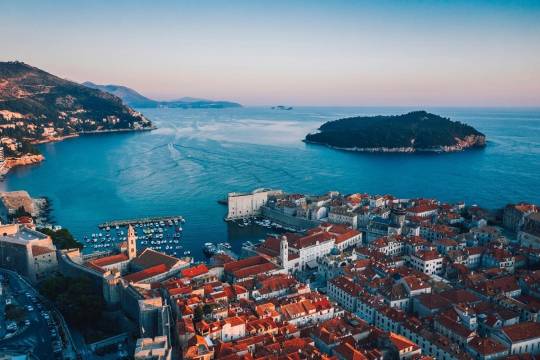
Written by Menswear Style in Travel on the 22nd February 2025 Croatia, a jewel in the heart of Europe, offers an alluring blend of stunning landscapes, rich history, and vibrant culture. This Mediterranean paradise has, over the last decade, transformed into one of Europe’s most sought-after travel destinations. With its picturesque coastline dotted with charming villages, breathtaking national parks, and ancient ruins, Croatia provides endless opportunities for adventure and relaxation alike. This year is particularly special, with exciting developments and events making it the perfect time to explore this enchanting country. Stunning Natural Beauty Croatia is renowned for its awe-inspiring scenery, which varies dramatically from region to region. On the Adriatic coast, visitors are greeted by crystal clear waters against the backdrop of rugged cliffs and idyllic islands. The nation's national parks are equally spellbinding; for example, Plitvice Lakes National Park features cascading waterfalls and lush greenery that create a fairy-tale landscape. This UNESCO World Heritage site showcases a vibrant palette of colors that change throughout the seasons, making it an ideal location for photographers and nature lovers alike. Also, Krka National Park, famous for its stunning waterfalls and extensive walking trails, allows visitors to immerse themselves in nature. It draws adventurers with its diverse flora and fauna, as well as opportunities for swimming in picturesque pools surrounded by lush vegetation. Whether hiking through wild landscapes or kayaking in crystal-clear waters, the natural beauty of Croatia offers something for everyone. Rich Cultural Heritage The cultural tapestry of Croatia is as rich and diverse as its landscapes. With a history that dates back to the Roman Empire, visitors will discover a treasure trove of historical sites that illustrate the country’s storied past. The ancient city of Dubrovnik, often referred to as the "Pearl of the Adriatic," is a UNESCO World Heritage site famed for its well-preserved medieval architecture. The city’s iconic walls, which surround the old town, provide stunning views of the Adriatic Sea and the surrounding landscape. Stepping inside, tourists can wander the cobblestone streets, visiting historical landmarks such as Sponza Palace and the Rector’s Palace, both of which narrate fascinating stories from the past. Beyond Dubrovnik, other cities like Split and Zadar boast impressive Roman ruins, including the well-known Diocletian's Palace. Built in the 4th century, this architectural marvel is now a vibrant hub filled with shops, restaurants, and captivating street performances that bring history to life. Croatia’s cultural celebrations, such as the Dubrovnik Summer Festival and the Split Music Festival, also highlight its vibrant arts scene and allow visitors to engage with local traditions. Delicious Cuisine No visit to Croatia is complete without savoring its delicious cuisine, which is a reflection of the country's diverse cultural influences. Croatian food varies by region, making every culinary experience unique. In coastal areas, the Mediterranean diet is predominant, featuring an abundance of fresh seafood, olive oil, and herbs. Dishes like grilled squid, octopus salad, and black risotto showcase the ocean’s bounty, captivating the taste buds of all who try them. Inland, hearty dishes dominate the menu, with meats, stews, and traditional pastries taking center stage. Specialties such as "pašticada," a marinated beef stew, offer a glimpse into authentic Dalmatian flavors, while various local cheeses and cured meats complement any meal. Visitors can also relish wine tasting, as Croatia has a thriving wine culture, with numerous vineyards and wine regions producing outstanding varietals. Enjoying a fine glass of wine alongside Croatian cuisine creates a gastronomic experience that keeps travelers returning. Adventure Awaits For those seeking adventure, Croatia presents an array of outdoor activities set against its stunning backdrop. The crystal-clear waters of the Adriatic Sea invite snorkeling, scuba diving, and sailing, while the scenic landscapes offer hiking and biking trails that cater to all skill levels. Kayaking around the islands of Hvar or sea kayaking in the peaceful waters of Mljet National Park provides an exhilarating way to explore hidden coves and secluded beaches. For a truly unique experience, a journey on a luxury yacht charter can transform a vacation into an unforgettable adventure. As explained by experts from chartering a yacht allows travelers to cruise along the captivating coastline, stopping at enchanting islands for swimming, sunbathing, and local exploration. This blend of luxury and adventure, enhanced by the beauty of Croatia's islands, provides a chance to experience extraordinary moments on the water. The Warmth of Croatian Hospitality One of the highlights of visiting Croatia is the warmth and friendliness of the locals. Croatians are known for their hospitality, making tourists feel welcomed and embraced by the culture. This genuine warmth creates a friendly atmosphere that enhances the travel experience, inviting visitors to engage with local customs and traditions. Whether enjoying a home-cooked meal with a local family or participating in traditional festivals, tourists are often reminded that they are not just visitors but part of a larger community. This sense of connection can be further amplified through guided tours and local experiences offered throughout the country. Tourists can explore lesser-known towns and villages, learning about the history and traditions directly from the people. Such interactions provide deeper insights into Croatia's culture, making the journey far more enriching. Vibrant Festivals and Events Another reason to visit Croatia this year is the diverse array of festivals and events celebrating everything from food to music. The landscape comes alive during the summer months when towns and cities host festivals that showcase local art, culture, and cuisine. The Dubrovnik Summer Festival, for instance, features various performances, including theatre, concerts, and dance, attracting artists from around the globe. Participating in these events not only provides entertainment but also fosters a connection with Croatian culture. Wine lovers should note the numerous wine festivals held across the country, showcasing the finest local vintages accompanied by traditional music and dance. Such gatherings are a festive celebration of Croatian heritage, offering visitors the chance to taste wines and learn about the procedures behind their production while enjoying live entertainment. Croatia is much more than a vacation destination; it represents a vibrant tapestry of history, culture, and natural beauty. With its stunning landscapes, rich heritage, diverse culinary scene, and commitment to eco-friendly tourism, there has never been a better time to visit. This year, immerse yourself in the warm hospitality of Croatia and create memories that will last a lifetime. /* */ Source link
0 notes
Photo

Written by Menswear Style in Travel on the 22nd February 2025 Croatia, a jewel in the heart of Europe, offers an alluring blend of stunning landscapes, rich history, and vibrant culture. This Mediterranean paradise has, over the last decade, transformed into one of Europe’s most sought-after travel destinations. With its picturesque coastline dotted with charming villages, breathtaking national parks, and ancient ruins, Croatia provides endless opportunities for adventure and relaxation alike. This year is particularly special, with exciting developments and events making it the perfect time to explore this enchanting country. Stunning Natural Beauty Croatia is renowned for its awe-inspiring scenery, which varies dramatically from region to region. On the Adriatic coast, visitors are greeted by crystal clear waters against the backdrop of rugged cliffs and idyllic islands. The nation's national parks are equally spellbinding; for example, Plitvice Lakes National Park features cascading waterfalls and lush greenery that create a fairy-tale landscape. This UNESCO World Heritage site showcases a vibrant palette of colors that change throughout the seasons, making it an ideal location for photographers and nature lovers alike. Also, Krka National Park, famous for its stunning waterfalls and extensive walking trails, allows visitors to immerse themselves in nature. It draws adventurers with its diverse flora and fauna, as well as opportunities for swimming in picturesque pools surrounded by lush vegetation. Whether hiking through wild landscapes or kayaking in crystal-clear waters, the natural beauty of Croatia offers something for everyone. Rich Cultural Heritage The cultural tapestry of Croatia is as rich and diverse as its landscapes. With a history that dates back to the Roman Empire, visitors will discover a treasure trove of historical sites that illustrate the country’s storied past. The ancient city of Dubrovnik, often referred to as the "Pearl of the Adriatic," is a UNESCO World Heritage site famed for its well-preserved medieval architecture. The city’s iconic walls, which surround the old town, provide stunning views of the Adriatic Sea and the surrounding landscape. Stepping inside, tourists can wander the cobblestone streets, visiting historical landmarks such as Sponza Palace and the Rector’s Palace, both of which narrate fascinating stories from the past. Beyond Dubrovnik, other cities like Split and Zadar boast impressive Roman ruins, including the well-known Diocletian's Palace. Built in the 4th century, this architectural marvel is now a vibrant hub filled with shops, restaurants, and captivating street performances that bring history to life. Croatia’s cultural celebrations, such as the Dubrovnik Summer Festival and the Split Music Festival, also highlight its vibrant arts scene and allow visitors to engage with local traditions. Delicious Cuisine No visit to Croatia is complete without savoring its delicious cuisine, which is a reflection of the country's diverse cultural influences. Croatian food varies by region, making every culinary experience unique. In coastal areas, the Mediterranean diet is predominant, featuring an abundance of fresh seafood, olive oil, and herbs. Dishes like grilled squid, octopus salad, and black risotto showcase the ocean’s bounty, captivating the taste buds of all who try them. Inland, hearty dishes dominate the menu, with meats, stews, and traditional pastries taking center stage. Specialties such as "pašticada," a marinated beef stew, offer a glimpse into authentic Dalmatian flavors, while various local cheeses and cured meats complement any meal. Visitors can also relish wine tasting, as Croatia has a thriving wine culture, with numerous vineyards and wine regions producing outstanding varietals. Enjoying a fine glass of wine alongside Croatian cuisine creates a gastronomic experience that keeps travelers returning. Adventure Awaits For those seeking adventure, Croatia presents an array of outdoor activities set against its stunning backdrop. The crystal-clear waters of the Adriatic Sea invite snorkeling, scuba diving, and sailing, while the scenic landscapes offer hiking and biking trails that cater to all skill levels. Kayaking around the islands of Hvar or sea kayaking in the peaceful waters of Mljet National Park provides an exhilarating way to explore hidden coves and secluded beaches. For a truly unique experience, a journey on a luxury yacht charter can transform a vacation into an unforgettable adventure. As explained by experts from chartering a yacht allows travelers to cruise along the captivating coastline, stopping at enchanting islands for swimming, sunbathing, and local exploration. This blend of luxury and adventure, enhanced by the beauty of Croatia's islands, provides a chance to experience extraordinary moments on the water. The Warmth of Croatian Hospitality One of the highlights of visiting Croatia is the warmth and friendliness of the locals. Croatians are known for their hospitality, making tourists feel welcomed and embraced by the culture. This genuine warmth creates a friendly atmosphere that enhances the travel experience, inviting visitors to engage with local customs and traditions. Whether enjoying a home-cooked meal with a local family or participating in traditional festivals, tourists are often reminded that they are not just visitors but part of a larger community. This sense of connection can be further amplified through guided tours and local experiences offered throughout the country. Tourists can explore lesser-known towns and villages, learning about the history and traditions directly from the people. Such interactions provide deeper insights into Croatia's culture, making the journey far more enriching. Vibrant Festivals and Events Another reason to visit Croatia this year is the diverse array of festivals and events celebrating everything from food to music. The landscape comes alive during the summer months when towns and cities host festivals that showcase local art, culture, and cuisine. The Dubrovnik Summer Festival, for instance, features various performances, including theatre, concerts, and dance, attracting artists from around the globe. Participating in these events not only provides entertainment but also fosters a connection with Croatian culture. Wine lovers should note the numerous wine festivals held across the country, showcasing the finest local vintages accompanied by traditional music and dance. Such gatherings are a festive celebration of Croatian heritage, offering visitors the chance to taste wines and learn about the procedures behind their production while enjoying live entertainment. Croatia is much more than a vacation destination; it represents a vibrant tapestry of history, culture, and natural beauty. With its stunning landscapes, rich heritage, diverse culinary scene, and commitment to eco-friendly tourism, there has never been a better time to visit. This year, immerse yourself in the warm hospitality of Croatia and create memories that will last a lifetime. /* */ Source link
0 notes
Text
Efficient Transfers in Zadar with Voyager Transfers
Voyager Transfers offers efficient and reliable transfers Zadar, making your travel around this beautiful city easy and convenient. Whether you need a transfer to the airport, a local attraction, or a nearby city, our transfers in Zadar provide a comfortable and stress-free solution. Our professional drivers and modern vehicles ensure a smooth ride, allowing you to relax and enjoy your journey. Choose Voyager Transfers for all your transportation needs in Zadar. Book your transfer today and experience the best service in the region!
0 notes
Text
Here are some of the top beach destinations in Europe
Amalfi Coast, Italy Famous for its picturesque villages, stunning cliffs, and crystal-clear waters.
Santorini, Greece Known for its unique black sand beaches and breathtaking sunsets over the caldera.
Costa del Sol, Spain – A popular region with beautiful beaches, vibrant nightlife, and charming towns like Marbella and Malaga.
Dubrovnik, Croatia Offers stunning beaches along the Adriatic Sea, combined with rich history and stunning architecture.
Provence, France Features beautiful beaches along the Côte d’Azur, like those in Nice and St. Tropez, along with scenic coastal towns.
Sicily, Italy Home to diverse beaches, from sandy stretches to rocky coves, all set against a backdrop of rich history and culture.
Ibiza, Spain Known for its lively nightlife, Ibiza also boasts stunning beaches and tranquil coves.
Mallorca, Spain Offers a mix of lively beaches and secluded spots, perfect for relaxation and adventure.
Biarritz, France A chic beach town known for its surf culture and beautiful coastline.
Cascais, Portugal Just outside Lisbon, it features gorgeous beaches and a charming seaside atmosphere.
Corfu, Greece Offers beautiful beaches with lush greenery and turquoise waters.
Paphos, Cyprus Known for its beautiful coastline and historical sites, perfect for beach lovers and history buffs alike.
Lake Bled, Slovenia While not a traditional beach destination, it offers beautiful lakeside views and swimming spots.
Hvar, Croatia Famous for its stunning beaches and vibrant nightlife, it’s a popular destination for sun-seekers.
Naxos, Greece Known for its beautiful sandy beaches and less crowded atmosphere compared to other Greek islands.
Tuscany, Italy Offers beautiful coastal areas like Viareggio and Forte dei Marmi, perfect for beach lovers.
Zadar, Croatia Features beautiful beaches and a charming old town with a rich Serbian history.
Rimini, Italy A well-known beach destination with a lively atmosphere and long sandy beaches.
Catania, Sicily Offers beautiful beaches with views of Mount Etna, providing a unique backdrop.
Bulgaria’s Black Sea Coast Known for affordable beach resorts and stunning sandy beaches like Sunny Beach and Nessebar.
These destinations offer a mix of beautiful scenery, culture, and activities, making them perfect for beach getaways!
By werentmarbella.com
0 notes
Text
The Best Time to Visit Croatia A Seasonal Guide

Croatia, with its stunning coastline, historic cities, and picturesque islands, is a top destination for travelers. The best time to visit Croatia depends on what you want to experience, whether it's sunny beaches, cultural festivals, or outdoor adventures..
Spring (March to May)
Pros:
Mild Weather: Spring in Croatia offers mild temperatures, ranging from 10°C (50°F) to 20°C (68°F), making it ideal for sightseeing and outdoor activities.
Fewer Crowds: Tourist spots are less crowded compared to the summer months, providing a more relaxed experience.
Blooming Nature: The countryside is lush and green, with wildflowers in full bloom, perfect for nature walks and hiking.
Cons:
Cooler Sea Temperatures: The Adriatic Sea might still be too cold for swimming.
Highlights:
Plitvice Lakes National Park: Witness the stunning waterfalls and clear blue lakes amidst spring greenery.
Dubrovnik: Enjoy the historic sites without the summer crowds.
Summer (June to August)
Pros:
Warm Weather: Ideal for beachgoers, with temperatures ranging from 25°C (77°F) to 35°C (95°F).
Festival Season: Numerous cultural festivals, including the famous Dubrovnik Summer Festival and Split’s Ultra Europe Festival.
Vibrant Nightlife: Coastal towns like Hvar and Split are buzzing with nightlife.
Cons:
Crowds and Higher Prices: Popular destinations can be very crowded and accommodation prices peak during these months.
Heat: It can get very hot, especially in July and August, which might be uncomfortable for some travelers.
Highlights:
Dalmatian Coast: Explore beautiful beaches and crystal-clear waters in places like Hvar, Brac, and the Makarska Riviera.
Island Hopping: Perfect time for sailing and discovering the many islands.
Autumn (September to November)
Pros:
Pleasant Weather: September still offers warm temperatures suitable for swimming, while October and November are cooler but comfortable for sightseeing.
Reduced Crowds: Fewer tourists make it easier to enjoy popular sites.
Harvest Season: Great time to experience local food and wine festivals.
Cons:
Shorter Days: Daylight hours decrease as the season progresses.
Unpredictable Weather: Rain becomes more likely in late autumn.
Highlights:
Istrian Peninsula: Known for its truffle season and wine harvests.
Zadar and Rovinj: Explore these charming coastal cities with fewer tourists around.
Winter (December to February)
Pros:
Lower Prices: Accommodation and travel costs are significantly lower.
Festive Atmosphere: Christmas markets in cities like Zagreb offer a unique experience.
Cons:
Cold Weather: Temperatures can drop to 5°C (41°F) or lower, particularly inland.
Limited Activities: Some tourist attractions and ferry services may be closed or reduced.
Highlights:
Zagreb: Renowned for its festive Christmas market, voted one of the best in Europe.
Skiing: Head to the mountainous regions for winter sports.
Conclusion
The Best time to visit Croatia ultimately depends on your preferences. For beach vacations and vibrant nightlife, summer is ideal despite the crowds. Spring and autumn are perfect for a blend of pleasant weather and fewer tourists, offering the best conditions for exploring the country’s natural beauty and historical sites. Winter, while colder and quieter, presents a unique charm with festive celebrations and lower travel costs. Whenever you choose to visit, Croatia's diverse offerings ensure a memorable experience.
0 notes
Text
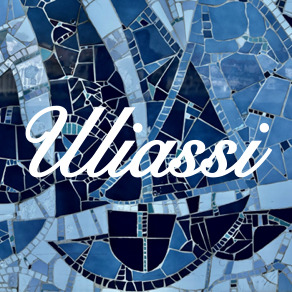
Uliassi
LOCALITZACIÓ - HISTÒRIA - PERSONES
L’Uliassi està situat a Senigallia, a la província d’Ancona (Le Marche), a l’alçada de Florència i Zadar (Croàcia). Es tracta d’un poble de la costa Adriàtica, d’uns 40.000 habitants, amb molta vida turística, un casc antic molt actiu i platges de sorra fina amb files i files d’hamaques.
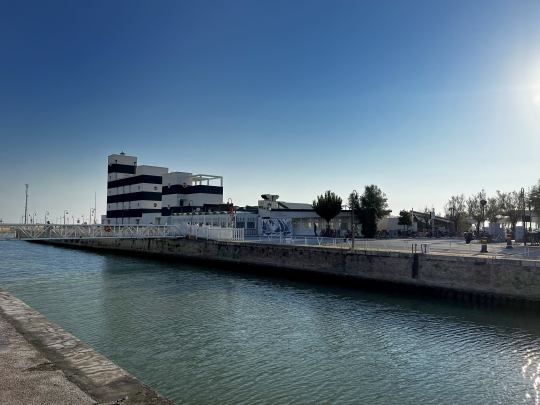
El restaurant, obert per en Mauro Uliassi (Senigallia, 1958) i la seva germana Catia Uliassi (Senigallia, 1967) l’any 1990, està situat ben bé a la platja, es podria dir que va néixer com un xiringuito al costat del canal on desemboca el riu Misa i al costat del mercat del peix del poble, amb unes galeres excepcionals. El local, amb la característica fusta blanca i les rajoles de la façana, sembla una localització atractiva tant de dia com de nit i durant totes les estacions de l’any, amb fred o calor i amb sol, pluja o vent.

Uliassi és un restaurant familiar. Des dels inicis, en Mauro ha estat a la cuina juntament amb en Mauro Paolini (marit de la Catia i amic d’en Mauro de tota la vida) i la Catia, a la sala. Actualment, els seus respectius fills, en Filippo Uliassi i en Gianmarco Paolini Uliassi, també es van introduint al negoci familiar. De fet, en Mauro i la Catia es van criar al Bar Uliassi (en un barri de Senigallia situat a les afores) que portaven els seus pares i que, actualment, dirigeix el seu germà Walter, un ex-pilot d’avió.
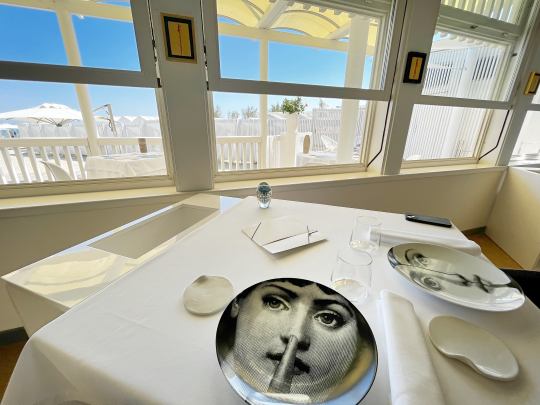
En Mauro és un cuiner que no s’ha format a l’alta restauració, tot i que, durant els primers anys del restaurant, anés a fer alguna estada amb cuiners com en Martín Berasategui, en Ferran Adrià, en Quique Dacosta i en Joan Roca. De la mateixa manera, la Catia (apassionada del disseny i la pintura i havent passat 2 anys a la Universitat) va anar a l’Enoteca Pinchiorri (Florència) i a Dal Pescatore.
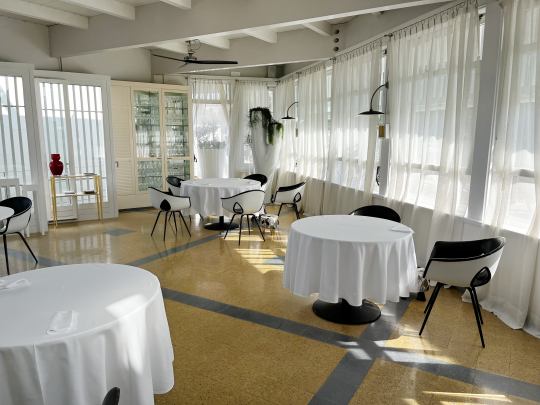
BREUS ANOTACIONS PRÈVIES SOBRE LA CAÇA A L'ULIASSI
El menú de caça d’en Mauro Uliassi em generava molta curiositat però, a la vegada, molts dubtes, sobretot perquè tenia entès que era reconegut com a cuiner de peix, però també perquè altres cuiners italians m’havien comentat que a Itàlia la caça estava completament prohibida i, també pel fet de servir un menú de caça a l’agost i arran de mar.
Em preguntava si seria de granja o salvatge; si seria d’Itàlia, concretament de Le Marche (recordem que els Apenins estan a pocs km de Senigallia), o d’altres països; si seria fresca, faisandada o congelada; si hi hauria disponibilitat a l’agost; quina varietat de tòfona i de quin origen devien utilitzar a l’estiu, etc. Per tant, vaig contactar amb en Mauro per a resoldre tots els meus dubtes i assegurar la nostra elecció.
Molt amablement, en Mauro em va explicar que, des del 2016, hi ha una llei que prohibeix servir caça als restaurants de tot Europa (entenc que vol dir de la UE). Resulta que els únics animals que es poden utilitzar són: perdius, faisans, llebres, ànec collverd, cabirols, cèrvols, colomins, que diu que es troben tot l’any (llebres tot l’any?). Animals com la becada (beccacce), el becadell comú(beccaccini, Gallinago gallinago), el tord (tordi), la merla (merli), el xarxet comú o anedó (alzavola, anas crecca), la grouse, etc., que solien adquirir a Escòcia, ara estan completament prohibits. Diu que la caça de l’Uliassi també pot ser de granja o congelada i que, per tant, per a ells no és un problema servir caça a l’estiu, ja poden fer molt amb el que troben. Finalment, confirma que el tartufo nero que serveixen juliol i agost és tuber aestivium.
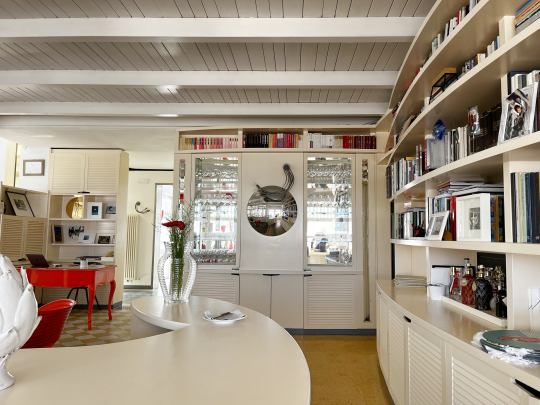
Llegint textos de La scienza in cucina e l'arte di mangiar bene (1891) de Pellegrino Artusi, una obra mestra de diferents cuines regionals d’Itàlia, veig que en aquestes latituds sembla que es cuinaven tones de tords, perdius, colomins, llebres… però que, en algun moment, es va perdre el costum. També llegeixo com en Mauro recorda quan anava a caçar amb el seu pare. Tanmateix, aviat van deixar de fer-ho, sobretot pel sentiment de llàstima cap els animals i perquè el món potser anava cap a una altra banda. Però al cap d’uns anys, va recuperar aquell record tan íntim de la tradició de Le Marche, que no només són galeres i raps, sinó també ànecs i colomins i, des del 2001, va tornar a servir el menú de caça.
ÀPAT
Pel que fa a l’oferta, hi ha la possibilitat de menjar a la carta (mínim 3 plats) o d’escollir un dels 4 menús (el Classico, l’Easy Classico de 6 plats, el Lab i el Caccia).
Vam fer el Menú Classico 2023 i li vam afegir alguns plats del Menú Caccia 2023 que també tenia especial interès en provar:
LOAKER DI FEGATO GRASSO E SHOT DI KIR ROYALE:
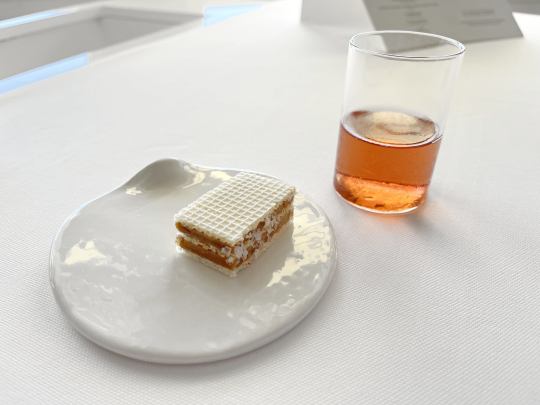
Loacker S.p.A. és una empresa de rebosteria italiana, amb seu a Tirol del Sud (Itàlia) i especialitzada en la producció d'hòsties, xocolata i productes derivats.
Un aperitiu més gros del que m’havia imaginat, en vaig poder fer 3 mossegades. El farciment de dins (el foie amb praliné d’avellana) està molt fred (sense arribar a ser un gelat) i és molt bo però la galeta/oblea no m’agrada, sembla una hòstia, la galeta dels gelats, i preferiria un altre tipus de massa. Un aperitiu que va introduir el cuiner Michele Rocchi l’any 2006 quan va tornar d’El Celler de Can Roca, d’on va treure la idea de servir un bombó com a amuse-bouche i pensant en la combinació foie-praliné d’avellana que ja havia vist d’en Frédéric Bau de Valrhona. Un aperitiu que ha esdevingut l’aperitiu emblemàtic de la casa i que tampoc deixa de ser un aperitiu bullinià pel fet de fer una clucada d’ull a un producte de la indústria alimentària com podria ser una Oreo, un Filipino o un corte helado.
Acompanyat d’un petit tastet de Kir Royale (Prosecco amb cassís, el licor de grosella negra) que no necessitaria.
MANTEGA D’ARENGADA FUMADA:
Escumosa, recordava l’olor del caviarper la salabror i el fumat. Molt bona.
OLI DE ROMANÍ:
Boníssim, tenia una densitat increïble, semblava un pur��. És una llàstima que no el serveixin en un plat blanc per poder-lo veure millor, segur que és preciós. Per fi un restaurant d’alta cuina que no ho hiper-filtra tot!
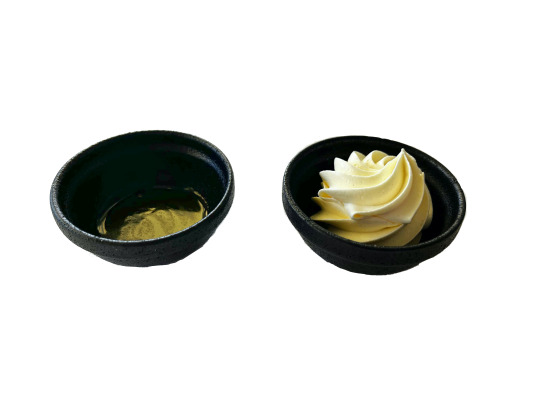
PLAT DE PA, tots fets amb massa mare:
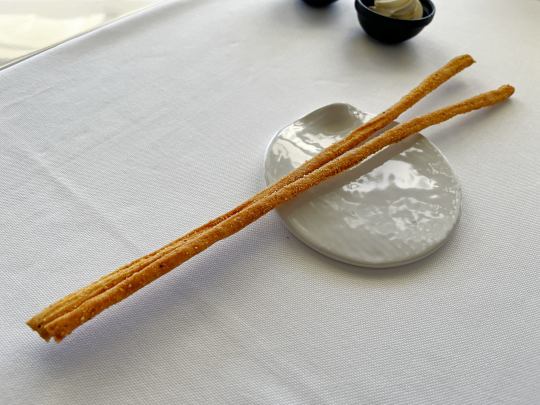
Grissini de blat de moro (fets per ells mateixos al restaurant, els deixen a una cambra de fermentació que tenen a la cuina).
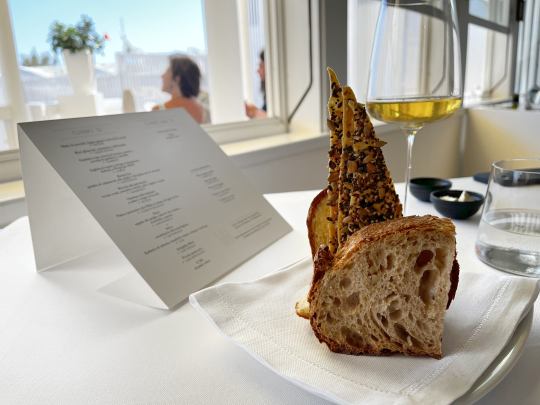
3 triangles amb llavors de lli daurat i lli marró: cruixent i calentó, el més bo i adequat per a un inici d’àpat. Amb un triangle per persona en tindria prou.
2 llesques de pa que anomenen “pizza al formaggio”: semblava un pa de mantega, com un brioix francès o pa de llet, era saladet, amb un tros de formatge Pecorino de Le Marche. Un pa molt bo, sobretot el tros que arreplegues de Pecorino, però trobo que és més per a menjar sol que no per a servir en un menú d’aquestes característiques perquè és massa intens i “embrut” el paladar.
1 llesca de pa blanc amb trossets d’una alga. Un pa que, tot i ser una recepta seva, els fa el forn Pandefrà (diria que els altres pans també són de Pandefrà). L’alga no es nota gens.
1 llesca de pa fet amb un gra antic. Correcte, ben fet però tampoc excepcional.
Sorprèn que d’un n’hi hagi 3 triangles, d’un altre 2 llesques i dels altres únicament 1 llesca de cada. Després vam poder veure que és que en van reposant durant tot l’àpat. No ho serviria així, en serviria 1 de cada a cadascú o els serviria d’un en un i a petició del comensal. També, com sempre que serveixen tants tipus de pans als restaurants, em semblen més per atipar que per a poder gaudir. Pel meu gust, no és el moment d’afartar-me de pa. I, també com sempre, deixen poc temps per a provar-los.
RICCI GHIACCIATI, MANDARINO, ZAFFERANELLA:
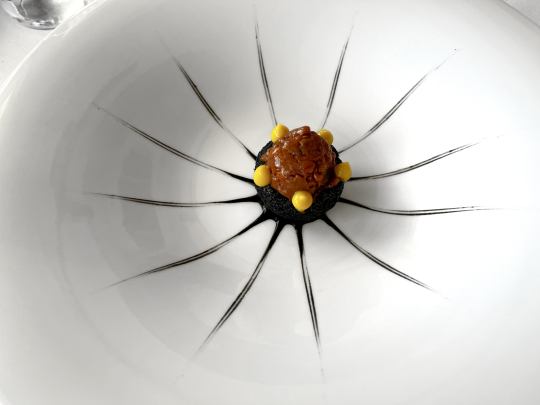
Una massa negra airejada i cruixent que podria ser de tinta de calamar, amb una textura un punt aritificial i, a més, tampoc estava ben feta del tot, no era que estés remullida però a la part central era més tova, potser era algo buscat.
A sobre, una “massa” de garoines de la Puglia servides gelades que, sense arribar a ser un granissat de garoines, va resultar ser una temperatura ideal de servei perquè es van desfer/atemperar de seguida tot generant un semifreddo i permetent que desprenguessin la seva deliciosa intensitat de mar. Boníssimes.
Els punts grocs eren de zaferanella, un safrà silvestre del Monte Conero de Le Marche.
Finalment, hi havia un punt groc/ataronjat a la base que era de mandarina i li aportava un puntet massa de gust de cítric, res terrible però es notava el toc. Aquest puntet amb textura cremosa i gust de mandarina, que si fes a casa només podria fer amb un Minipimer, està fet amb un evaporador/destil·lador rotatiu (un rotovap o rotavapor), una màquina que extreu l’aigua d’un líquid a uns 30ºC (i entenc que al buit) aconseguint-ne un extracte/concentrat.
GAMBERO ROSSO, BUCCIA DI ARANCIO, ZENZERO, CERVELLA DI GAMBERO E CANNELLA:
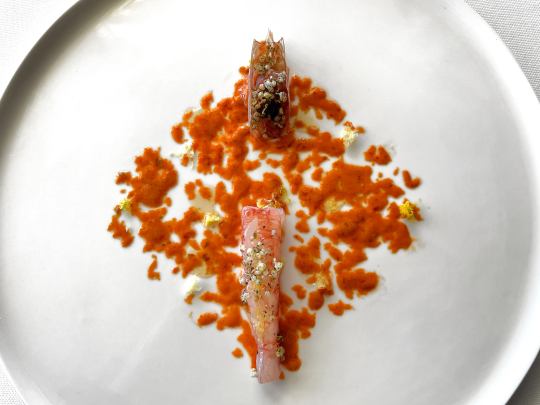
Una gamba vermella servida crua i freda però a molt bona temperatura, amb aquest punt de fredor que li permetia desprendre la seva melositat.
L’olor era més de cítrics que de gamba però eren uns cítrics ben diferents als nostres, més suaus, més fragants i menys agressius, semblaven ben bé els perfums de les taronges i llimones de Sicília i Garda. En canvi, en boca sí que es notava la gamba i la barreja de la seva dolçor amb la dolçor d’aquesta pell de taronja de Sicília tant excepcional; també apareixia el toc de canyella i menys, el gingebre. Una combinació que a prioi em semblaria totalment errònia però duta a terme de manera exquisida. Un plat que em sembla molt representatiu de la manera genial que té en Mauro Uliassi de combinar els sabors.
La part del cap era el “cervell”, la melsa lilosa/morada/rosada del cap servida amb l’esclòvia més externa del cap, sense la part de les “antenes”.
Tot plegat, servit amb un toc de quinoa suflada que li aportava un punt cruixent molt delicat.
El calibre de la gamba (la cua menjada en 2 mossegades, tot i que la serveixen sencera) hagués pogut ser un punt més gros.
SOGLIOLA AL VAPORE, LATTUGA E BERGAMOTTO CANDITO:
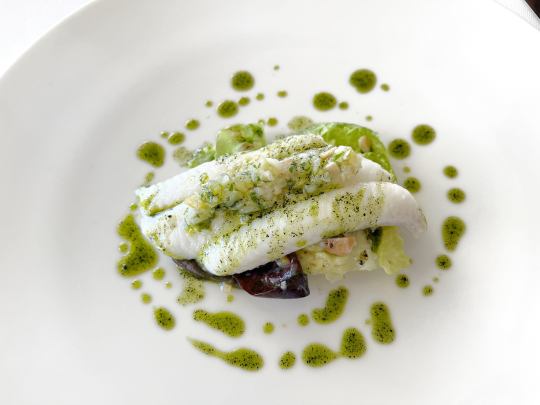
Tot i que no ho expliquen quan serveixen el plat, aquest està dedicat a Piergiorgio Parini, un cuiner del 1977 que va treballar al Povero Diavolo* del 2006 al 2016, del propietari Fausto Fratti, a Torriana (Rimini, Emilia-Romagna) i que va deixar per a començar el seu projecte). Va tenir 1* del 2011 al 2016.
Un llenguado cuit al vapor, amb bona textura però servit sense pell i de gust molt suau, massa neutre. Un tros d’un filet de llenguado ben gruixut, podria ser perfectament d’un llenguado de 1,5-2 kg.
La salsa verda era d’algues. També hi ha escopinyes amb pebre i llimona.
Potser, en aquest cas, el gust és un punt massa cítric (de bergamota) però el joc de textures era molt bo.
L’enciam era deliciós, amb el cruixent dels trossets d’avellana, el gust de cítrics i tot ben tebi i sucós.
RIMINI FEST. Spiedino di calamaretti alla griglia sulla brace e shot ghiacciati di citronette:
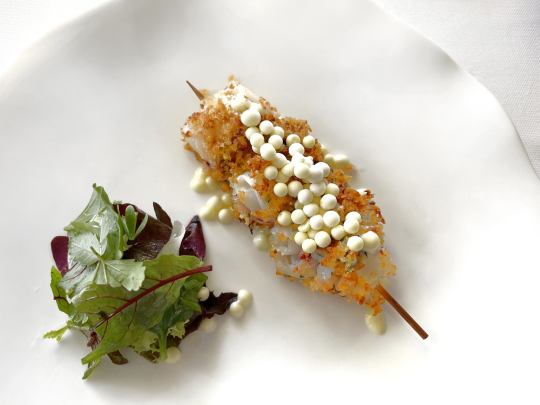
Tot i que tampoc ho expliquin d’entrada, pregunto el per què del nom del plat i resulta que són els records que en Mauro Uliassi té de Rimini, de quan era un jove cuiner i vivia la festa d’aquesta ciutat de costa.
Un semifreddo deliciós. Per una banda, el calamar fet a la brasa de carbó, tallat a trossets, amb potes i tot, servit ben calent i, per sobre, amb un pa ratllat i fregit que li aportava una textura cuixent i oliosa, com una mena de Panko; i, per altra banda, les boletes blanques gelades de salsa citronette (una salsa a base d’oli d’oliva i suc de llimona) que es desfeien per sobre. Un calamar boníssim, quina textura tant fina!
En un bol a part, un “gazpacho” de mango amb cogombre, pinya i alfàbrega. Una mena de chutney molt agradable i referscant amb un puntet picant molt suau que debia venir d’un toc de shrirasha o algun tipus de bitxo.
RICCIOLA E SCAMPI ALLA PUTTANESCA. Ricciola cruda, pomodoro, basilico, alici, capperi, rucola:
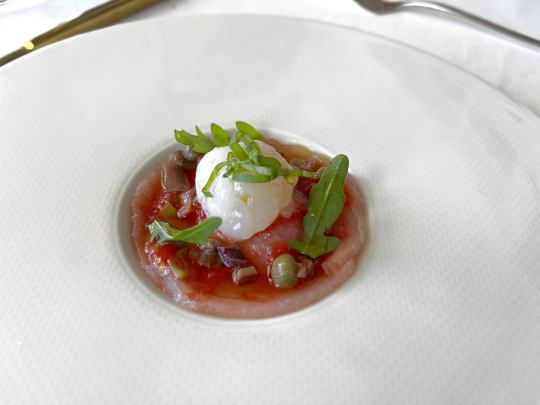
Una serviola crua i, a la base, un carpaccio finíssim d’escamarlans.
Alla puttanesca, una salsa típica del sud d’Itàlia que acostuma a companyar la pasta i que és a base de tomàquet, tàperes, anxoves i olives.
Un plat fresquíssim. Fa olor d’alfàbrega, peix i tomàquet, olor de frescor. A dins, tenia 3 petits crostons de pa fregit. Un pèl petit (per agafar pràcticament tot d’una mossegada) però deliciós. L’únic plat que ens va semblar excessivament petit.
OSSOBUCO ALLA MARINARA:
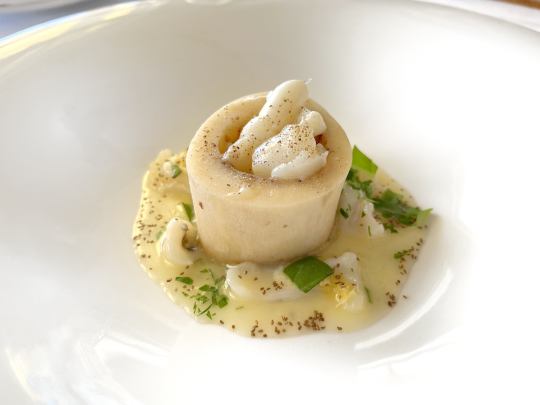
Servit amb campana que destapen a l’uníson a taula.
Moll de l’òs (de vedella) cuit en aigua de cloïsses i servit amb tripa de bacallà, alfàbrega i llavors de mostassa. Utilitza tripa salada (de salaor, no utilitza tripa de bacallà fresc) i de bacallà d’Islàndia.
Servit tebi. La salsa era boníssima, amb gust d’api, fulles de julivert i l’aigua de cocció de les cloïsses. Textures agradables: la melositat del moll de l’òs (de textura tova i fina i poc enganxós), la melositat de la tripa (de textura més cartilaginosa però més enganxosa que el moll de l’òs pel seu col·lagen) i el suquet/salsa de cloïsses (de textura més sucosa i menys enganxosa).
Quina bona idea coure el moll de l’òs a l’aigua de les cloïsses!
Un plat que desitjava provar especialment, que m’havia imaginat deliciós i que va estar a l’alçada de les aspectatives tant a nivell aromàtic com a nivell de les diferents melositats.
PASTA E POMODORO ALLA HILDE, in infuso di foglie di fico:
També, servit amb campana.
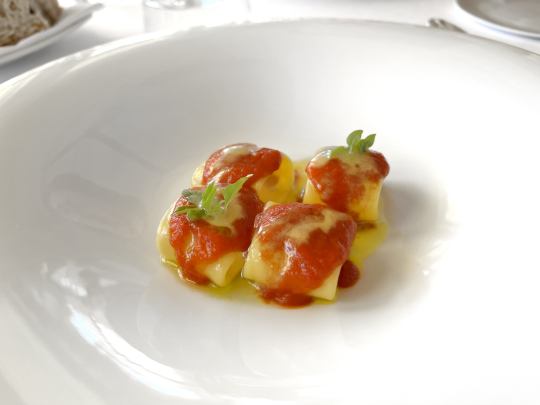
Quina olor de figa! Quina pasta més bona! Al dente, deliciosa. Sabor i aroma. Sucós. El parfum de figa de la salsa de tomàquet és increïble. Resulta que utilitza les fulles de figa perquè, aromàticament, s’assemblen a les branques i fulles de les tomaqueres. Doncs bé, ell infusiona les fulles de figuera amb mantega durant 1 hora a 60ºC i, després, passa la pasta per una paella amb aquesta mantega.
La salsa de tomaca és a base de Pomodori del Piennolo del Vesuvio DOP fets al forn 2h a 100ºC i després tamisats per un sedàs per obtenir aquesta textura densa, sedosa i lleugerament aromatitzada amb all i alfàbrega.
Tot i que no ho expliquin, ja havia llegit que és un plat dedicat a Hilde Soliani, una creadora de perfums i gastrònoma.
Tota la pasta que utilitzen és de Pietro Massi.
Ens canvien el tipus de plat de pa per un plat blau i blanc Feeling’s de Sylvie Coquet.
SPAGHETTI AFFUMICATI, VONGOLE E POMODORINI DATTERINI ARROSTITI:
També, servit amb campana. Un plat que ens van afegir ells per cortesia.
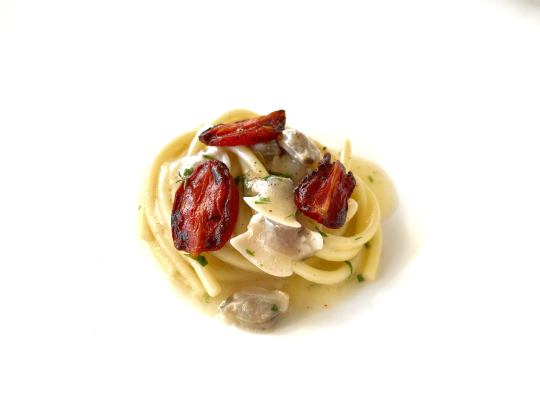
Quan menges els espaguetis es nota el fumat d’haver-los cuit en un brou d’anguila fumada, eren boníssims. Hi ha tres tomaquetes deshidratades (per ells, en una cambra d’assecat, uns prestatges a dins un armari que funciona amb aire calent i un ventilador) i algunes cloïsses de la mida d’una escopinya.
Molt bo però atipa massa i és un plat que no haguéssim demanat, tampoc va resultar ser excel·lent.
MARE O SELVA:
Et fan triar si fer el plat de mar o el de bosc. En fem un de cada, així els veiem tots dos.
MARE: SPIGOLA ALLA GRIGLIA, SALSA DI VINO BIANCO, MORCHELLE E PESCHE:
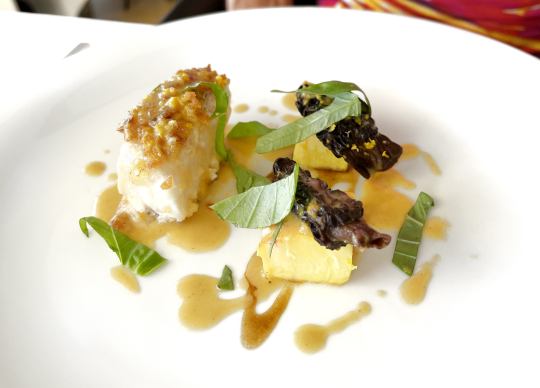
Un tros de llom de llobarro fet a la brasa (la mateixa on hi fan el calamar), servit sense la pell i amb una crosta de pa ratllat (com la dels calamars però més gruixut). Un pa blanc de farina de Le Marque que compren fresc, assequen i ratllen especialment per a aquests dos plats.
Servit amb dos daus de préssec de textura surosa, els havien fet a la brasa i van quedar secs i durs, em va estranyar (més aviat negativament) la textura. A sobre d’aquests daus de préssec, dues múrgoles prou correctes. La salsa de vi blanc, mantega i cítrics era deliciosa! Poc gust de peix però molt sucós, es desfeia a llesques.
SELVA: COLOMBACCIO ARROSTITO ALLA MARCHIGIANA E UN CROSTONE COL PATÉ DELLE INTERIORA:
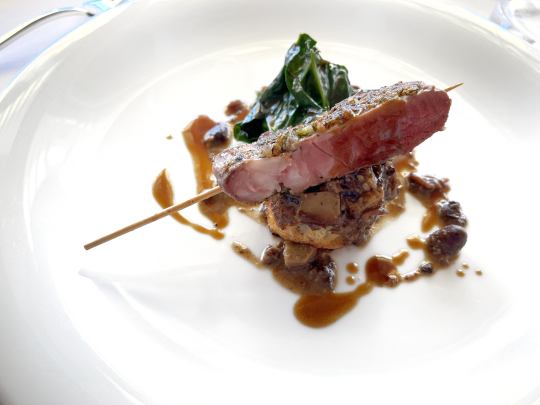
Entenc que vam menjar colomí perquè en Mauro em va comentar que “colombacci sono piccioni selvatici detti anche palombe”.
El pit d’un colomí d’Itàlia servit desossat (cosa que s’agraeix) però enfilat en una broqueta (cosa que no entenc perquè no el menjo d’allà directament i el primer que vaig fer va ser treure-li el palet de fusta i servir-lo al plat). A sota, un crostó d’un pa un pèl dolcet farcit amb un paté dels interiors del colomí saltejats amb mantega, cognac i foie gras. Com sempre, la torradeta amb els interiors, que sembla l’actor secundari, és el més bo i el més gustós. També hi havia uns dauets d’aranja.
Diuen que a la marquesana és amb llard i herbes aromàtiques com el fonoll silvestre.
L’únic plat de caça del menú dels clàssics. No vam trobar el perdigó. Un plat molt bo però no excepcional.
TARTARE DI LEPRE, GRANITA DI RICCI DI MARE, OLIO DI GINEPRO:
El primer dels 3 plats que vaig voler afegir.
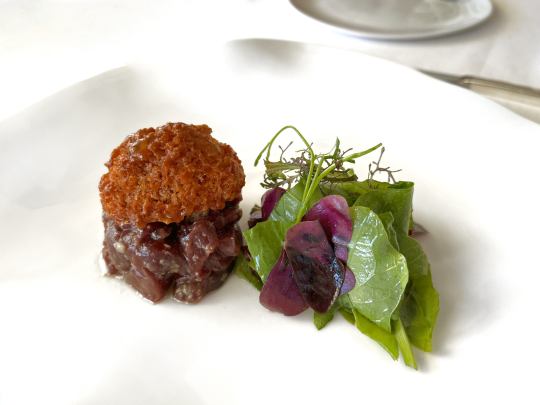
Uau, molta més olor de garoina que la garoina gelada d’aperitiu! Unes garoines molt intenses (mar, algues) i ben fresques servides a sobre d’una llebre d’Itàlia, crua i marinada amb un oli de ginebró que no vaig ni notar, una llebre tendríssima que no va fer cap tendrum. Un mar i muntanya servit semifreddo que es desfeia molt de pressa. Dos ingredients “fèrrics”. Al costat, unes fulles amb vinagre. Tot plegat, boníssim.
ROYALE DI GERMANO CON GRANITA DI LAMPONE:
El segon dels 3 plats que vaig voler afegir.
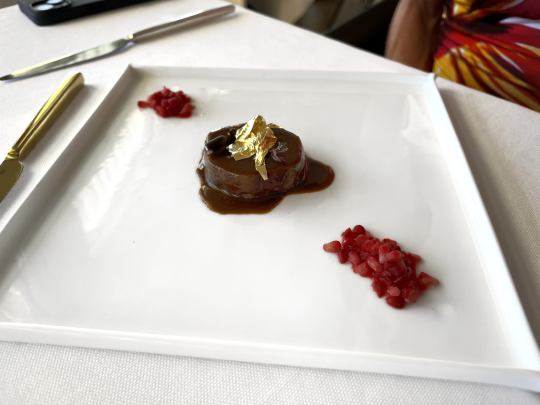
Doncs bé, tal com em semblava des de casa, no era una royale sinó à la royale. Una variació de la llebre à la royale canviant la llebre per ànec collverd, és a dir, un canard à la royale. Una recepta que no pot ser més francesa i feta de la manera més clàssica, amb el foie al centre i amb sang a la fosca salsa que napa la carn. També portava un trosset de xocolata a sobre, l’or també per sobre (inconfusible clucada d’ulls a Gualtiero Marchesi, remarcant la majestuositat d’una recepta reial) i un coulis di lamponi (més que una granita), és a dir, un coulis de gerds amb petits dauets sencers que no hi pintava res (mai necessito aquestes fruites vermelles per a menjar caça, trobo que el punt de frescor i desengreixant que aporta va en detriment del gust, no m’agrada la combinació caça-fruita) i que, per sort, estava servit a un costat del plat. L’únic plat un pèl esquifit del menú però, atès que eren plats d’a més a més, ja va ser raonable.
PETTO DI FAGIANELLA, OSTRICA, OLIO DI PERILLA E SEMI TOSTATI:
El tercer dels 3 plats que vaig voler afegir.
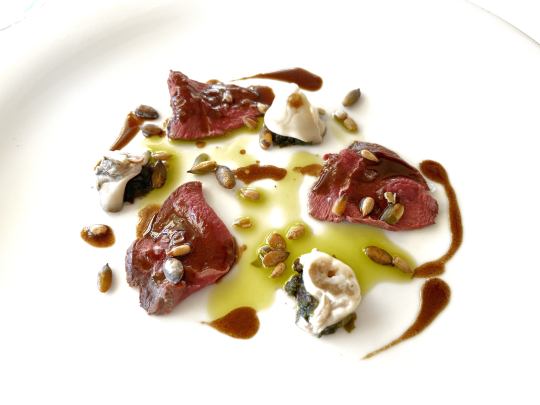
Tres talls finets d’un pit de faisà que semblava ben bé una carn vermella (sobretot a nivell visual, pel seu intens color vermell) amb una ostra tallada en tres, gens integrada amb el faisà i que ens hagués agradat menjar més freda. Una carn tendra i bona però no va ser un plat excepcional.
PRE-POSTRES:
SORBETTO DI CABOSSA, MANDORLE TOSTATE, MANGO, MERINGA, FAVE DI CACAO:
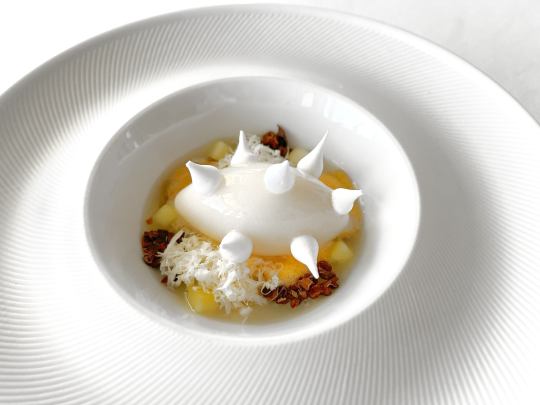
Un sorbret de cabossa, el muccilaggio, és a dir, la part blanca de dins del fruit del cacau, que conté el mucílag.
Les llàgrimes blanques eren unes petites merengues.
Els daus de xocolata semblaven els dauets de bajoca de cacau que utilitzen al Lot per a fer una infusió de xocolata.
POSTRES:
SENIGALLIA-BREST. Crema chantilly alla vaniglia, ciliegie ghiacciati e olive nere caramellate:
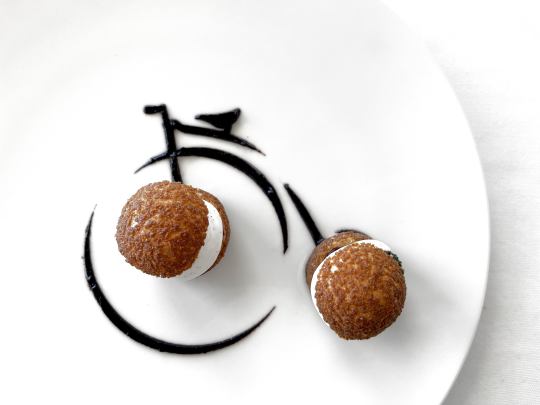
Un giro in bicicleta sulla Senigalia a Brest. Una revisió del clàssic pastís París-Brest (una mena de tortell fet amb pasta choux, semblant a la massa de les profiteroles, partit per la meitat i farcit de xocolata o crema i praliné d’avellana).
En aquest cas, eren 2 peces de la mida d’un macaron o una profiterola. La massa estava fregida i tenia gust de xuixo, era cruixent, molt bona. M’hagués agradat notar més les olives negres, que estaven deshidratades, caramel·litzades i amanides amb oli i fonoll silvestre. Molt bo però en serviria un i prou i com a petit four, ja que la mida i el format ho semblen.
PICCOLA PASTICCERIA:

Gerd gelat, farcit del licor Maraschino i amb una fulla d’alfàbrega a sobre.
Cub de xocolata blanca amb un gelat de coriandre a dins.
Dacquoise al coco, amb xocolata blanca i gingebre.
Gelatina d’albercoc i cardamom.
Crumble de xocolata amb Peta-Zetas.
Cilindre de meló en osmozi, amb menta.
VAM BEURE
Fontanasanta Nosiola 2020 de Foradori, un blanc de maceració pel·licular elaborat per l’Elisabetta Foradori, una de les productores de vi de les Dolomites més reconeixibles i apreciades. Un vi amb aquest caràcter nítid que sempre té el seu Nosiola i que segueix sorprenent-nos i encantant-nos en una maceració pel·licular. Ideal per a acompanyar tot un menú de variacions gustatives tant marcat com el de l’Uliassi.
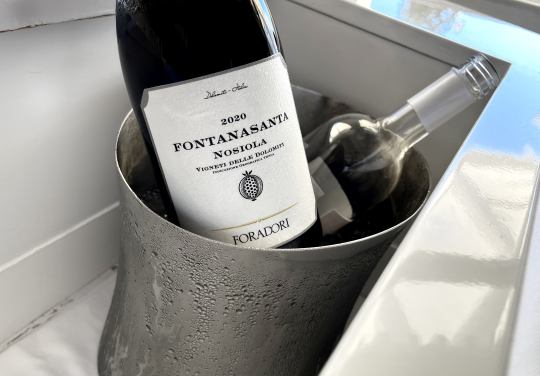
Per a acompanyar tant l’ànec à la royale com el pit de faisà amb ostra, ens van servir una copa de Col d’Orcia 2018, un Brunello di Montalcino ben madur, equilibrat i ben fet però no és el nostre tipus de vi. Una Sangiovese en bóta d’Eslavònia (a l’est de Croàcia).
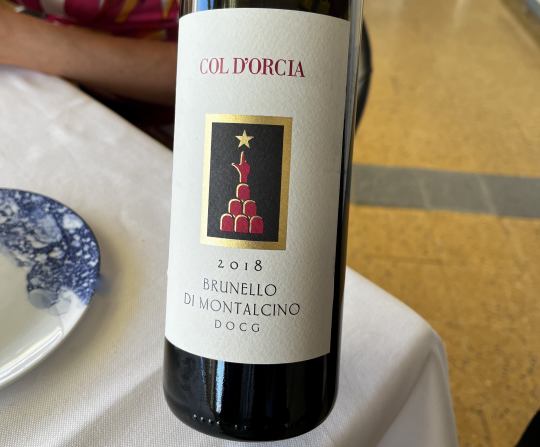
CONCLUSIONS
Recordo perfectament la primera persona que em va parlar de la cuina d’en Mauro Uliassi. Va ser l’estimat Vedat Milor l’any 2010. 13 anys després, finalment, hi menjo.
En Mauro Uliassi és un cuiner polifacètic amb tres línies ben diferenciables que són el peix (recordem que sempre és peix fresc, que el que el madura és en Moreno Cedroni), la caça i aquesta mirada tant ben entesa de la cuina bulliniana, demostrant conèixer-ne tant les tècniques com la filosofia i l’essència de les idees d’en Ferran Adrià i, a més, sabent-les aplicar a la seva cuina (a la cuina de la seva regió i a la seva cuina personal) amb seny i saviesa, de manera molt ben executada i sota una cuina figurativa i no abstracta.
Vaig quedar impressionada pel seu domini combinant sabors. Sobretot, el domini que té de cítrics com les taronges, la mandarina, la bergamota, les aranges o el suc de llimona per a la salsa citronette però també del gingebre, el ginebró o la canyella. O també el toc aromàtic que aporta de manera indirecta als productes, tal com fa amb la mantega d’arengada fumada, bullint la pasta en un brou d’anguila fumada o fent la cocció del moll de l’òs amb l’aigua de cocció de les cloïsses. O les associacions i harmonies gustatives que fa, com la ferrositat de la llebre i la garoina.
Per exemple, a priori, penso que combinar una gamba vermella amb pell de taronja és un sacrilegi típic de cuiners que no respecten el producte. Però quin senyor plat el de la gamba! El sabor d’aquestes taronges sicilianes és inoblidable. Normalment, la pell de taronja aporta un gust artificial, exogen, que en el pitjor dels casos pot arribar a recordar detergents de lavabos emmascarant els sabors. Però les taronges de l’Uliassi són parfum, no són excessivament àcides, són equilibrades, delicioses. També, en un principi, em sembla molt agoserada la idea d’afegir safrà i mandarina a una garoina (la de l’aperitiu) però, en canvi, aconsegueix fer-ho de manera brillant. També a nivell aromàtic i gustatiu, és molt destacable la fulla de figuera de la seva salsa de tomàquet pel plat de pasta e pomodoro alla Hilde, inoblidable i deliciós.
De la seva cuina destaco els plats de peix (especialment la gamba) i els mar i muntanya, molt presents també a la cuina catalana (especialment el deliciós moll de l’òs amb tripa de bacallà) però no em van semblar excepcionals els plats 100% de caça com el colomí o el germano à la royale.
De la seva cuina també destaco (per la seva abundància i pel seu domini) les temperatures de servei genialment pensades com són tota la colla de semifreddo que ens va brindar, el servei a diferents temperatures dels diferents ingredients d’un plat: un gelat (que sempre es desfà ràpidament, mai sent gel picat com si fos per a un mojito), un altre atemperat i, finalment, de vegades, fins i tot un tercer element calent, com un brou. Un altre aspecte també molt bullinià.
També és remarcable la qualitat dels productes. Les garoines eren excel·lents, molt diferents de les de la Costa Brava o Galícia. No em puc ni imaginar com deuen ser les del Japó! La qualitat de la gamba, dels calamars i, sobretot, la qualitat i frescor dels ingredients secundaris que acompanyen els plats: cítrics, espècies, herbes, fulles, fruites, etc.
A més, la mida de les racions de tots els plats és molt bona. Serveix la quantitat suficient per a poder-ne fer algunes cullerades donant la possibilitat de menjar i disfrutar del gust del plat.
També em van agradar molt els tempos entre plat i plat, deixant temps per a disfrutar del post-gust, preparar el paladar pel següent plat, anar digerint i podent gaudir de les vistes però sense deixar passar massa estona tornant-se feixuc. No hi ha gens d’storytelling i vam estar molt a gust; això sí, sabien respondre tot el que preguntàvem i, sinó, ho consultaven i acabaven responent.
Finalment, el servei també és molt bo, impecable. Aparentment, sembla un equip molt sòlid, tant el de cuina com el de sala, fet que diu molt de la casa i demostra lleialtat i fidelitat, diàleg i bones maneres, tant per part dels treballadors com per part dels Uliassi. Sense anar més lluny, Ivano Coppari, el sommelier, treballa a la casa des de l’obertura, fa 33 anys, i la major part del personal fa 10 o 20 anys que són a la casa, on s’hi van incorporant gent jove com en Gabriel, un cambrer ben jove que era de Senigalia mateix i que també ens va atendre perfectament.
Tot i que tenien les finestres obertes i en algun moment va fer una mica de calor, la taula i l’espai són molt confortables.
Sorprenen alguns elements decoratius (entre carrinclons i un punt excessius o fins i tot vulgars) com els plats Fornarina que hi ha servits al principi de l’àpat i retiren de seguida, la medusa de sobre la taula, el canelobre-florero, els ganivets d’or, els retrovisors de trànsit (que més que una obra d’art podrien ser algun record de l’època festiva de Rimini d’en Mauro) o la tauleta vermella FAKE de la terrassa, entre d’altres.
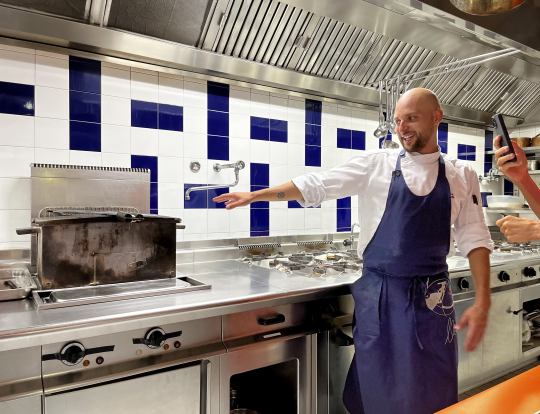
Vaig demanar de veure la cuina i el cuiner Luca Musella (també de Senigalia), que fa 6 anys que treballa a l’Uliassi, ens la va ensenyar i explicar fil per randa, responent amb entusiasme i total predisposició totes les preguntes i dedicant-nos el seu temps. Pel que fa a l’espai, està distribuïda per partides: primers (entrants/antipasti), segons, crus, entrada de mercaderies i la pastisseria. D’entrada, em fixo que té gas: 10 fogons als primers i una cuina Fourneaux Molteni preciosa, antiga, vermella i daurada, de la línia 1923, als segons. També té 2 planxes als primers i 1 als segons, 1 brasa de carbó i 1 salamandra als primers.
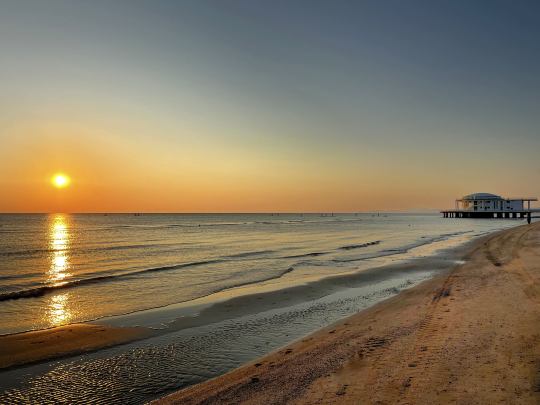
En resum, tot i que en Mauro Uliassi i en Mauro Paolini no estessin presents, vam fer un molt bon àpat. L’acolliment de la Catia Uliassi i el seu equip de sala i de cuina van ser suficient per a no sentir-nos decepcionats i quedar-me amb ganes de tornar per a poder provar el menú Lab i plats com el seu ”Brodetto all’anconeta”, el “Rombo alla plancha, calamaretti, salsa bruciata di cipollotti e peperoni”, la “Grouse, semi tostati, ostrica e succo di grouse”, l’agnello fuori di testa, la “Beccaccia per 6 beccacce” o la seva “cassata” de postres, que són mostres de la seva cuina, una cuina identitària amb caràcter propi i regional.
0 notes
Text
Visit the City of Nin, Croatia.
Along the coastal region of Croatia in the Mediterranean region of Eastern Europe, lies a small seaside city called Nin. An once capital city of Croatia during the Medieval Times and the first city of royalty with King Branimir (see statue below) standing on the front entrance of the city's port. Now, here is where I get a bit nepotistic about Nin and I'll be honest, I don't get any money from the city of Nin for writing this post too. My father was born in this city and raised here since the age of 21, when he left the former Yugoslavia to head to America for better opportunities. After the Balkan Wars in the early to mid-90s, Croatia, now its own country, began rebuilding the country into a mecca tourist attraction from the current capital city of Zagreb to Dubrovnik at King's Landing, based on the hit TV series, A Game of Thrones.
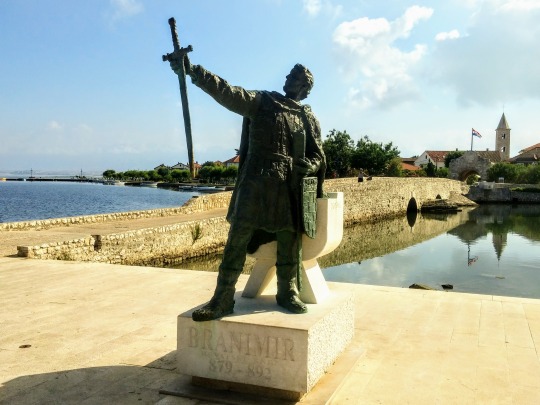
A statue of King Branimir 879 A.D.-892 A.D.
Many tourists that come to Croatia from all over the world, have visited the hot spots such as Split, Dubrovnik, Reikija, Hvar and the Island of Pag. Nin may not be a hot spot for young tourists who want to party all through the night, but Nin has many attractions to offer its tourists. The city is labeling itself as "Romantic City", where older tourists with a spouse can visit the city and have a great time at bars, restaurants, cafes, and other attractions with its magnificent sunsets over the lagoon that even appeases photographers capturing the beauty of Nin.
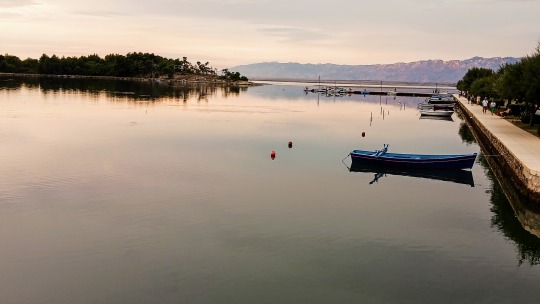
A lagoon in Nin.
Tourists have heard about Nin from many travel agencies in Europe and of course, locals from other parts of Croatia. Advent photographers and videographers, such as I, have photographed many parts of Nin to capture its rustic look and ancient architecture that dates back to Roman Times.
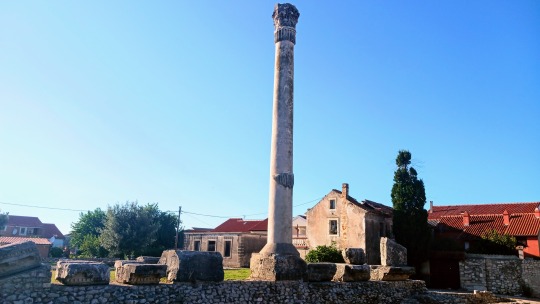
The Roman Temple built in the 1st Century A.D. in Nin.
The city offers a vast shopping center inside the island city for souvenirs, food, toys, and rental apartments for tourist to stay. In addition, the city offers an abundance of tourist information for out of towners by visiting the Tourist Board Nin office. Every summer, the circus is in town for children who seek fun and excitement while vacationing with their parents during the holiday school break. Kids can also swim at Queen's Beach, which is filled with activities such as kite surfing and boating.
Strole through the city and see many of the old churches such as the Church of the Holy Cross and the Church of St. Anselm. The churches have been there for centuries, including St. Nicolas Church, which is outside the city's walls.

St. Nicolas Church in Nin.
Every summer both the Tourist Board and the city put on many concert events featuring performances from musicians, theater performers and bands from all over Europe. Now as much as I would like to display the many events that are upcoming, just visit the Tourist Board Nin's website at this address: Calendar of events - Tourist board Nin Croatia.
Now for food and dining, I am particular with mostly American food such as pizza, burgers, and grilled barbeque, but Croatia's food is to me and I am being a bit favorable me being a Croat, but the food is really good. Try heading on over to Pizzeria Peperoni, in which, Tripadvisor.com gave the restaurant a high ranking on their website. If you're craving for a burger, head on over to Mad Duck restaurant where a charbroiled burger with melted mozzarella cheese melted into the burger, reminds me of back home in America.
As far as apartment renting, expect to pay around 800 Euros to 1,500 Euros a month, pending on the number of guests staying in the apartment. Car rental is found in Zadar and don't forget that many tourists can also camp with their trailers in the area of Zaton while viewing the beautiful beaches of Zaton.
To come to Nin, Croatia this summer or next, visit your nearest travel agency or go online to some of the top travel sites on the web. All photos were done by the author of this post. To follow the author, please visit the following social media sites.
Twitter: @johnnykera
Instagram: @johnnykera
Facebook: @johnnykera
YouTube: htttp://www.youtube.com/co/JohnKera
PayPal to donate: @523productions
Also, subscribe to my Tumblr page as I will be writing new content about Croatia and post some amazing photos of my upcoming travel destinations.
1 note
·
View note
Text

Sali, Dugi Otok, Northern Dalmatia🇭🇷
#Sali#travelarim#slow travel#balkan#croatia#dalmatia#island#hdr#dugi otok#village#northern dalmatia#zadar region
7 notes
·
View notes
Text
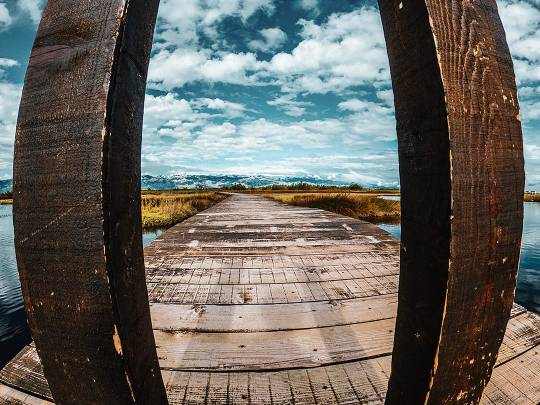
Love this view! It looks as if you could go directly into the mountains to climb up to the sky…
#croatia#zadar region#zadarcroatia#mountains#this view#summer#summermood#vacation#vacation 2020#vacation style#gopro8#goprohero8black#goprotravel#itsnevertoolate#itsnevertoolate...#photography#travel
4 notes
·
View notes
Text

#zadar#zadarcroatia#zadar region#croatiafullofnature#croatialove#croatiafulloflife#nature#sun light#sun#sunset#nofilter#nofilterneeded
2 notes
·
View notes
Text

I am so lucky to live in such a beautiful place
1 note
·
View note